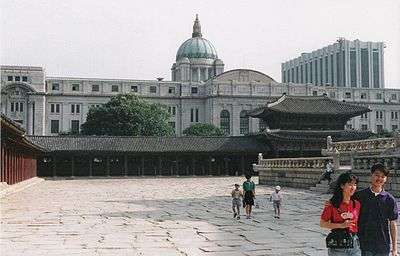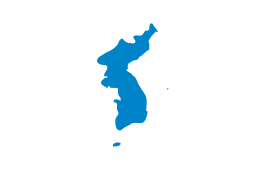Governor-General of Korea
The Governor-General of Chosen was the chief administrator of the Japanese colonial government in Korea from 1910 to 1945.
| Governor-General of Chosen
Chōsen Sōtoku (朝鮮総督) | |
|---|---|
 | |
 | |
| Residence | Official residence of the Governor-General of Korea |
| Seat | Government-General Building, Keijō |
| Appointer | |
| Precursor | |
| Formation | 1 October 1910 |
| First holder | Terauchi Masatake |
| Final holder | Nobuyuki Abe |
| Abolished | 12 September 1945 |
| Succession | |
The Governor-General of Chosen was established shortly after the Korean Empire was formally annexed by the Empire of Japan in the Japan–Korea Treaty of 1910 to replace the title of Resident-General. The Governor-General of Chosen was appointed from Tokyo and accountable to the Emperor of Japan. The Governor-General of Chosen was responsible for colonial government affairs in Korea, including infrastructure, culture, justice, and the suppression of freedom of speech and the Korean independence movement.[1][2]
The Governor-General of Chosen was seated in the General Government Building in Keijō (Seoul) after its completion in 1926.[3]
History

After the annexation of Korea to Japan in 1910, the office of Resident-General was replaced by that of Governor-General. However, the position was unique in among Japan's external possessions, as the Governor-General had sweeping plenipotentiary powers, and the position also entailed judicial oversight and some legislative powers. As of 1944, the Governor-General did not command the Imperial Japanese Army or Imperial Japanese Navy units stationed in Korea.[4] Given the powers and levels of responsibility, only ranking full generals in the Japanese Army were selected for the post (with the sole exception of retired admiral Saitō Makoto).
The Governor-General of Chosen had a police organisation, which may have been partly involved in having Korean women working as comfort women.[5]
After the Japanese defeat in World War II, the Korean Peninsula was administrated by the Democratic People's Republic of Korea and the Republic of Korea. The Governor-General building was completely demolished during administration of South Korean president Kim Yong-Sam on August 15, 1995.
Prime Ministers of Japan
Four individuals who held the position of the Governor-General of Korea also held the office of the Prime Minister of Japan. Three, Terauchi Masatake, Saitō Makoto, and Koiso Kuniaki, were Governors-General before becoming Prime Ministers. One, Abe Nobuyuki, was Prime Minister before his appointment as Governor-General. Ugaki Kazushige was named Prime Minister-designate, but he could not take office because he was unable to form a cabinet.
In addition, Resident-General Itō Hirobumi served four terms as Prime Minister prior to his appointment to Korea.
Residents-General
.svg.png)
From 1906 to 1910, Korean Empire became a protectorate of Japan and Japan was represented by a Resident-General in the Korean Empire.
- Prince Itō Hirobumi (1905–1909)
- Viscount Sone Arasuke (1909)
- General Viscount Terauchi Masatake (1909–1910)
Governors-General
After the annexation of Korea to Japan in 1910, the office of Resident General was replaced by that of Governor-General.
- General Count Terauchi Masatake 寺内 正毅 (1910–1916)
- Gensui Count Hasegawa Yoshimichi 長谷川好道 (1916–1919)
- Admiral Viscount Saitō Makoto 斎藤 実 (1919–1927)
- General Ugaki Kazushige 宇垣 一成 (1927)
- General Yamanashi Hanzō 山梨半造, (1927–1929)
- Viscount Saitō Makoto 斎藤 実 (second time 1929–1931)
- General Ugaki Kazushige 宇垣 一成 (second time 1931–1936)
- General Minami Jirō 南次郎 (1936–1942)
- General (ret'd) Koiso Kuniaki 小磯 國昭 (1942–1944)
- General (ret'd) Abe Nobuyuki 阿部信行 (1944–1945)
See also
References
- Kim, Djun (2005). The History of Korea. Greenwood Press. ISBN 0-313-33296-7.
- Governor-General of Korea. 統計年報[Statistics Annual Report]
- 黄文雄 Kō Bun'yū 歪められた朝鮮総督府 [Distorted facts about Governor-General of Korea](in Japanese).光文社 Kobunsya
- The building was completely destroyed during administration of South Korean president Kim Yong-sam on August 15, 1995.
- Grajdanzev, Andrew (2007). "The Government of Korea". Modern Korea (2 ed.). Orchard Press. p. 238. ISBN 978-1-4067-3825-4.
- 西岡力 Tsutomu Nishioka 政府は名誉回復の戦いを止めてはならぬ [The Japanese government must not stop demanding the restoration of honour] in Seiron March 2016 (in Japanese).産経新聞社 [Sankei Shimbun Sya]. p.83
